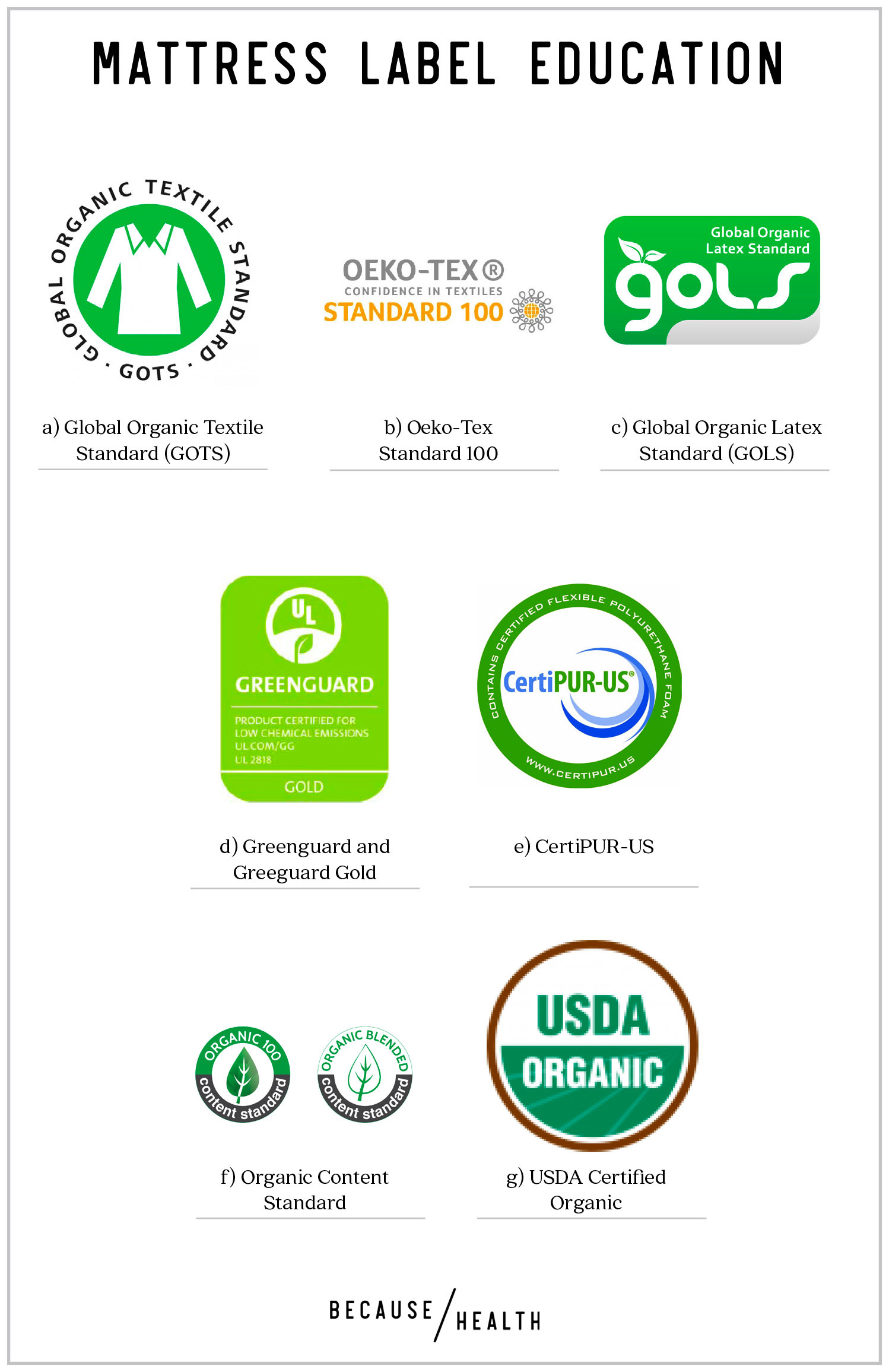What All Those Certifications on Mattresses Actually Mean
Label Education: Decoding what GOTS, GOLS, Greenguard, Organic, and more mean
Choosing the right mattress is so important for sound sleep and health, yet with so many options the shopping can be confusing and stressful! Obviously you want to take comfort and pricing into consideration, but there are some chemical ingredients you might want to consider too. Standard synthetic foam mattresses can contain various harmful chemicals we don’t want to be sleeping on. And these chemicals can evaporate into the air, or collect in house dust, which is yucky and no good for your family’s health.
The great news is that there are a bunch of healthier alternatives, and these labels below can help you find them. We also have a roundup of 12 non-toxic mattress brands if you just want a quick guide to organic mattresses and natural mattresses you can buy.
One tip as you look at these labels: while avoiding synthetic foam altogether is best, if that isn’t possible for you, there are three certifications (Certi-PUR, Oeko-Tex, and Greenguard) that can help you find the healthiest foams. For natural materials like latex or cotton, GOLS (Global Organic Latex Standard) or GOTS (Global Organic Textile Standard) have got you covered.
Wondering about VOCs (volatile organic compounds)? These are unhealthy chemicals that slowly leak out of foam and other materials and end up in the air you breathe. Many of the labels restrict VOC emissions, but just so you know, the strongest restriction for total VOCs is GREENGUARD Gold. If you are especially concerned about VOCs, look for mattresses with that label.
Good luck, and once the hunt is done, enjoy sleeping on a mattress that is not only comfy but also healthier for you and the planet.

a) Global Organic Textile Standard (GOTS)
What is it? Certifies the processing, manufacturing, packaging, labelling, trading, and distribution of mattresses and textiles made from at least 70% certified organic natural fibers. There are two label grades: 1) “organic” (over 95% organic fibers) and 2) “made with X% organic materials” (70-95% organic content). See our article, what does organic mean?
Read details on standards or search the product database (select Retailing or Mail Order).
Environmental Health: Many toxic chemical restrictions, including any chemicals linked with cancer, reproductive problems, genetic defects, or organ damage, or are harmful to the environment. Mattresses cannot be made of polyurethane foam. Natural latex mattresses can receive GOTS certification.
b) Oeko-Tex Standard 100
What is it? Certifies that mattresses and textiles do not contain or release certain harmful chemicals. Every component of the mattress (all inner and outer materials) must meet the chemical restrictions to earn the certification. Search the product database (look for the three mattress categories under Product Type).
Environmental Health: Many toxic chemical restrictions, including limits on emissions of total and specific VOCs (volatile organic compounds). Read details on chemical standards here. Synthetic foams are allowed as long as they meet the chemical restrictions.
c) Global Organic Latex Standard (GOLS)
What is it? Certifies latex mattresses containing at least 95% organic latex, with chemical restrictions for both the latex and non-latex parts. Read details on the standard.
Environmental Health: Emissions of total and specific VOCs are restricted. Use of certain toxic flame retardants and other chemicals are banned. Cotton fills and coverings must be certified by GOTS or Organic Content Standard-100 (see below). Synthetic latex and other synthetic foams are not permitted. Synthetic fabrics and fibers are permitted in interiors of products.
d) GREENGUARD and GREENGURAD Gold
What is it? Restricts emissions of VOCs (volatile organic compounds) from mattresses and other products. There are two labels: 1) GREENGUARD and 2) GREENGUARD Gold (previously called Greenguard Children & Schools Certification)
Environmental Health: Emissions of total and specific VOCs are restricted. GREENGUARD Gold has stricter restrictions. Read details on the emissions limits (see p.3). Search the product database (select the certification type and the product type in sidebar). Read more details on the standard (registration required to access free PDF). Some certified products have an additional formaldehyde-free verification.
e) CertiPUR-US
What is it? Certifies that polyurethane foam in mattresses (and other products) meet standards for chemical ingredients, emissions of VOCs, and durability. View a list of companies selling products containing certified foam (including but not limited to mattresses).
Environmental Health: Requires that polyurethane foam be made without heavy metals and without certain types of phthalates and flame retardants. This does not mean the products are completely free of potentially harmful phthalates or flame retardants. Emissions of total and specific VOCs are restricted. Read about the chemical restrictions.
f) Organic Content Standard
What is it? Verifies that mattresses and other products contain the stated amount of organic material, ranging from 5-100%. There are two seals: Organic 100 (for 100% organic) and Organic Blended (for all other amounts).
Environmental Health: Assures presence and amount of stated organic content. Organic materials must be grown and processed per established standards like USDA Certified Organic. Chemicals added to raw materials during manufacturing (dyes, finishes, etc.) are not addressed. View a list of companies certified to the organic standard.
g) USDA Certified Organic
What is it? USDA seal verifies that agricultural products are grown and processed per organic standards. “Certified organic” means at least 95% of the ingredients are organic. “Made with organic” means 70-94% of ingredients are organic. Only “certified organic” products can bear the seal. Fiber materials in mattresses can include cotton, wool, hemp, and linen.
Environmental Health: Fiber materials must be grown and processed per USDA Organic standards for food, without use of synthetic pesticides and fertilizers. GOTS and GOLS (see above) both meet USDA Organic standards. Note that USDA Organic does not address toxic chemicals that may be found in the non-organic components. Read What Is An Organic Mattress? from the Organic Trade Association.
